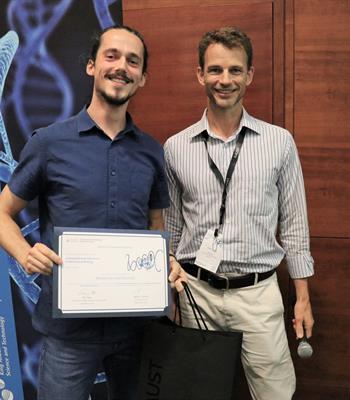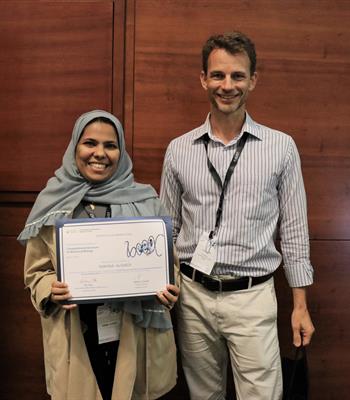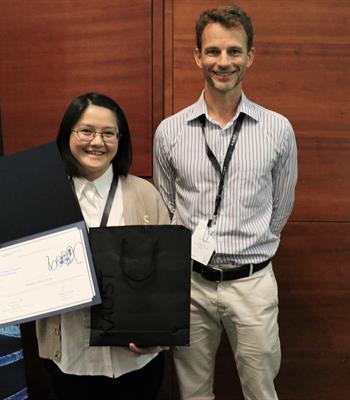KAUST Research Conference
Computational Advances in Structural Biology
May 1 - 3, 2023 Auditorium between building 4 & 5
The poster competition was judged by the following panelist:
Poster competition winners were as the follows:
Abstract:
Maintaining protein homeostasis in response to changing conditions is crucial for cellular survival and proper function. Since plants cannot adapt by changing their location, their need for a rapid intracellular response is accentuated. The AAA ATPase CDC48 maintains protein homeostasis with cofactors NPL4 and UFD1 by coupling ATP hydrolysis with mechanical force generated by large structural changes to extract and unfold ubiquitylated proteins from organelle membranes, chromatin, or protein complexes. Bioinformatic analyses revealed considerable domain and binding motif differences in A. thaliana cofactors compared to orthologs in animals and fungi. These differences were corroborated by ITC, MST, and SEC-MALS, where we found an absence of heterodimerization between cofactors and unique interactions independently with CDC48A. Using Cryo-EM, we provide the first complete structures of A. thaliana CDC48A in multiple nucleotide-bound and unbound states, reconstructed with resolutions ranging from 2.9 Å – 4 Å. Further, we reconstructed multiple conformations of crosslinked CDC48A-NPL4-UFD1B, revealing insights into the molecular mechanisms enabling substrate recruitment in A. thaliana. Through our efforts, we have observed unique differences in the interaction between A. thaliana proteins that may correspond to functional differences between kingdoms.

Abstract:
Understanding the complex interplay between multi-omics genetic factors in multifactorial diseases is key to developing effective corresponding treatments. One promising area of research is the use of network medicine approaches to identify key regulatory nodes in protein interaction networks that may contribute to multifactorial diseases. In this work, we interpret the molecular mechanisms of the biomarkers and biological signaling pathways linked to such risk factors and body system responses. To our best knowledge, there is limited research that analyzes molecular network interactions between multi-omics risk factors and drug targets of multifactorial diseases such as COVID-19, Diabetes Mellitus, and Alzheimer's disease to predict potential therapeutic targets and treatments for rheumatoid arthritis (RA). We developed the Risk Omics Causal Knowledge Enrichment Tool (ROCKET), a web tool that curates medical articles and biomedical platforms to construct and mine semantic knowledge graphs to provide a computational multi-omics network analysis of the risk factors and predict drug targets and biomarkers for diseases according to disease mapping and molecular function similarities between risk factors. As a case study, we used ROCKET for RA and identified three key proteins, RASGP1, TGFB1, and IRAK1, involved in three main pathways and are potential drug targets for RA. Moreover, we demonstrate that IL1RN, as a causal risk factor of RA, contributes to regulating T-cell memory in lung tissues and is associated with Alzheimer’s disease. Our study suggests that drugs approved for the treatment of diseases mapped with RA may be repurposed for other therapies if they shared common genetic factors and pathways. Four risk factors are identified as potential biomarkers and drug targets for RA. We provide new insights into disease pathogenesis and enhance drug discovery for complex traits.

Abstract:
We propose a new microscopy simulation system that can depict atomistic models in a micrograph visual style, similar to the results of physical electron microscopy imaging. This system is scalable, able to represent the simulation of electron microscopy of twenty viral particles and synthesizes the image faster than previous methods. On top of that, the simulator is differentiable, both its deterministic as well as stochastic stages form signal and noise representations in the micrograph. This notable property has the capability for solving inverse problems by means of optimization and thus allows for the generation of microscopy simulations using the parameter settings estimated from real data. We demonstrate this learning capability through two applications: (1) estimating the parameters of the modulation transfer function defining the detector properties of the simulated and real micrographs and (2) denoising the real data based on parameters trained from the simulated examples. While current simulators do not support any parameter estimation due to their forward design, we show that the results obtained using estimated parameters are very similar to the results of real micrographs. Additionally, we evaluate the denoising capabilities of our approach and show that the results outperform state-of-the-art methods. Denoised micrographs exhibit less noise in the tilt-series tomography reconstructions, ultimately reducing the visual dominance of noise in direct volume rendering of microscopy tomograms.
